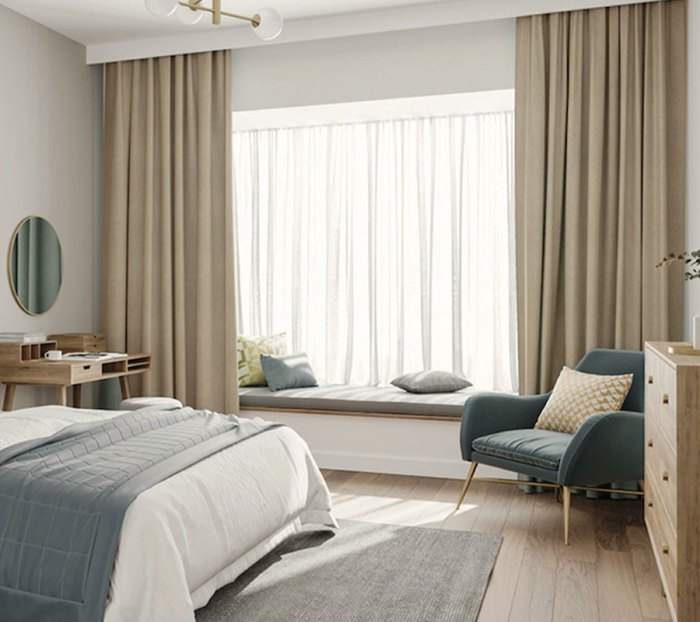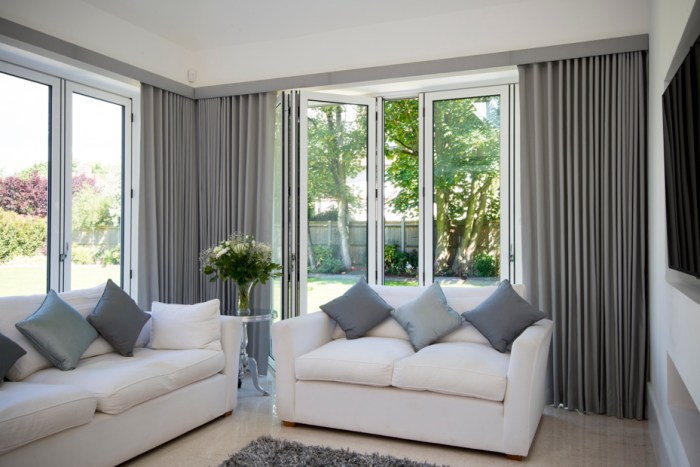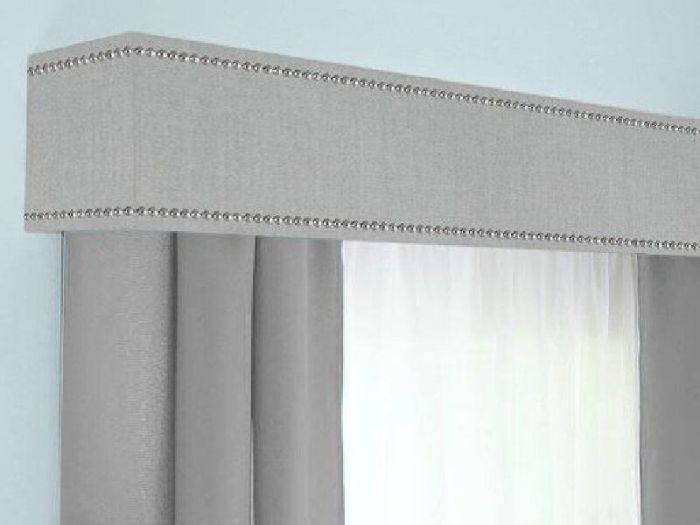Embark on a journey of design discovery with ideas for pelmets, where elegance meets functionality. From classic box styles to sophisticated tailored designs, explore a world of possibilities that will transform your windows into stunning focal points.
Delve into the realm of fabrics, colors, and patterns, unlocking the secrets of creating pelmets that harmonize seamlessly with your home decor. Discover the art of selecting the perfect trim and embellishments, adding those finishing touches that elevate your pelmets to masterpieces.
Pelmet Styles

Pelmets are decorative window treatments that can add a touch of elegance and style to any room. They come in a variety of styles, each with its own unique look and feel.
The three main types of pelmets are box, tailored, and curved. Box pelmets are the simplest and most common type of pelmet. They are made from a single piece of fabric that is stretched over a frame and attached to the wall above the window.
Tailored pelmets are more elaborate than box pelmets. They are made from multiple pieces of fabric that are sewn together to create a more tailored look. Curved pelmets are the most decorative type of pelmet. They are made from a single piece of fabric that is curved to follow the shape of the window.
Box Pelmets
Box pelmets are the most basic type of pelmet. They are made from a single piece of fabric that is stretched over a frame and attached to the wall above the window. Box pelmets are a good choice for rooms with a simple, modern décor.
They can also be used to add a touch of color or pattern to a room.
Tailored Pelmets, Ideas for pelmets
Tailored pelmets are more elaborate than box pelmets. They are made from multiple pieces of fabric that are sewn together to create a more tailored look. Tailored pelmets are a good choice for rooms with a more formal décor. They can also be used to add a touch of luxury to a room.
Curved Pelmets
Curved pelmets are the most decorative type of pelmet. They are made from a single piece of fabric that is curved to follow the shape of the window. Curved pelmets are a good choice for rooms with a more traditional décor.
They can also be used to add a touch of drama to a room.
Fabric Options

Pelmets can be crafted from a variety of fabrics, each offering unique characteristics that impact their aesthetics and functionality.
The choice of fabric depends on factors such as the desired style, durability, and light control requirements.
Velvet
Velvet is a luxurious and elegant fabric known for its soft, plush texture. It provides excellent light blockage and creates a cozy and intimate atmosphere.
However, velvet is prone to dust and dirt accumulation and may require frequent cleaning.
Silk
Silk is a delicate and opulent fabric that exudes sophistication. It allows some light to filter through, creating a soft and ethereal glow.
While silk is visually stunning, it is also more expensive and requires careful handling to prevent damage.
Linen
Linen is a natural and durable fabric that offers a crisp and clean look. It is relatively easy to maintain and provides good light control.
However, linen can be prone to wrinkling and may not be suitable for all styles.
Color Schemes
Color plays a crucial role in the aesthetic appeal of pelmets. Here’s a comprehensive guide to help you choose the perfect color scheme for your pelmets:
When selecting colors, consider the overall decor of the room. Neutral colors like white, beige, or gray can complement any style, while bold colors can create a dramatic focal point.
Neutral Color Options
- White: A classic choice that adds brightness and a clean look.
- Beige: A warm and inviting neutral that complements both light and dark interiors.
- Gray: A versatile neutral that can be paired with any color scheme.
Bold Color Options
- Blue: A calming color that evokes tranquility and sophistication.
- Green: A refreshing color that brings nature indoors and creates a sense of harmony.
- Red: A bold and energetic color that adds drama and warmth to a space.
Pattern Ideas

Pelmets with patterns can add visual interest and depth to a room. They come in various styles, from classic florals to modern geometric designs.
Patterns can create a focal point, draw attention to specific architectural features, or complement the existing decor.
Floral Patterns
- Floral pelmets bring a touch of nature indoors, creating a serene and inviting atmosphere.
- Choose floral patterns that complement the color scheme and style of the room.
- Large-scale floral patterns can make a bold statement, while smaller-scale patterns can add a subtle touch of elegance.
Geometric Patterns
- Geometric patterns add a modern and sophisticated touch to a room.
- They can create a sense of order and symmetry, or add a touch of playfulness with asymmetrical designs.
- Consider using geometric patterns in neutral colors for a timeless look, or opt for bolder colors to make a statement.
Striped Patterns
- Striped pelmets can create a sense of height or width in a room, depending on the orientation of the stripes.
- Vertical stripes can make a room feel taller, while horizontal stripes can make it feel wider.
- Striped patterns can also add a touch of nautical or preppy style to a room.
Trim and Embellishments
Trims and embellishments are the final touch that can elevate the design of a pelmet. They add a layer of detail and interest, and can help to coordinate the pelmet with the rest of the room’s décor.
There are many different types of trim and embellishments that can be used on pelmets, including:
Fringe
- Fringe is a classic trim that adds a touch of elegance to any pelmet.
- It is available in a variety of materials, including silk, cotton, and velvet.
- Fringe can be used to create a variety of looks, from formal to casual.
Hardware Considerations
Pelmets require hardware for support and attachment. The type of hardware used can influence the overall style and functionality of the pelmet.
The choice of hardware depends on the weight and size of the pelmet, as well as the desired look and feel. For heavier pelmets, sturdier hardware is necessary to ensure proper support. For lighter pelmets, more decorative hardware can be used.
Rods
Pelmet rods are the most common type of hardware used for pelmets. They are available in various materials, including wood, metal, and plastic. The diameter and finish of the rod should complement the style of the pelmet.
Brackets
Brackets are used to support the rod and attach it to the wall or ceiling. Brackets can be decorative or simple, depending on the desired look.
Rings
Rings are used to attach the pelmet to the rod. They can be made of metal, plastic, or wood, and can be decorative or simple.
Installation Methods
Installing pelmets can be a straightforward process with the right tools and a bit of preparation. Here’s a step-by-step guide to help you achieve a professional-looking finish:
Before you start, gather the necessary tools and materials:
- Pelmet
- Measuring tape
- Level
- Drill
- Screws
- Stud finder (optional)
- Pencil
Step 1: Determine Pelmet Placement
Use a measuring tape to determine the desired height and width of the pelmet. Mark the placement on the wall using a pencil.
Step 2: Find Wall Studs
Locate the wall studs using a stud finder. This will ensure that the pelmet is securely attached to the wall.
Step 3: Drill Pilot Holes
Drill pilot holes into the wall studs at the marked placement. The pilot holes should be slightly smaller than the screws you will be using.
Step 4: Attach the Pelmet
Align the pelmet with the pilot holes and secure it using screws. Ensure that the pelmet is level by using a level.
Tips and Tricks
- If you’re installing a heavy pelmet, consider using toggle bolts for added support.
- Use a spacer block between the wall and the pelmet to create a more professional look.
- Paint or stain the pelmet to match your décor.
- Add decorative trim or embellishments to enhance the style of the pelmet.
Design Considerations

When designing pelmets, consider the room size, window shape, and overall decor. Pelmets can enhance the aesthetics and functionality of a space, so it’s important to choose the right one.
Room Size
In smaller rooms, opt for a simple pelmet that won’t overwhelm the space. A narrow pelmet or a pelmet with a light, airy fabric can create the illusion of more space.
Window Shape
For arched windows, a curved pelmet can complement the shape and add a touch of elegance. For bay windows, a pelmet that follows the angle of the window can create a cohesive look.
Overall Decor
Consider the style of the room when choosing a pelmet. A traditional pelmet with ornate details can complement a classic decor, while a modern pelmet with clean lines can enhance a contemporary space.
DIY Pelmet Ideas
Crafting enthusiasts can explore unique DIY pelmet projects to add a personal touch to their window treatments. Here are a few creative ideas with step-by-step instructions:
Fabric-Covered Pelmet
- Gather materials: fabric, batting, wood or foam board, staple gun, scissors, measuring tape, pencil.
- Measure and cut the wood or foam board to the desired pelmet size.
- Wrap the batting around the board and secure it with staples.
- Lay the fabric over the batting and smooth it out, securing it with staples along the edges.
- Trim any excess fabric and display the pelmet.
Wooden Slat Pelmet
- Gather materials: wooden slats, wood glue, clamps, nails, hammer, measuring tape, pencil.
- Cut the wooden slats to the desired length and width.
- Apply wood glue to the edges of the slats and clamp them together.
- Nail the slats together to secure them.
- Attach the pelmet to the wall or window frame.
Upcycled Cardboard Pelmet
- Gather materials: cardboard, fabric, glue, scissors, measuring tape, pencil.
- Cut the cardboard to the desired pelmet size and shape.
- Cover the cardboard with fabric, securing it with glue.
- Add embellishments or paint to the pelmet for a decorative touch.
- Mount the pelmet on the wall or window frame.
Pelmet Trends
Pelmets are making a comeback in home decor, and they’re more stylish than ever before. Here are some of the latest trends in pelmet design:
Materials:Pelmets are now being made from a variety of materials, including fabric, wood, metal, and even glass. Fabric pelmets are the most popular, and they come in a wide range of colors and patterns. Wood pelmets are a more traditional choice, and they can add a touch of warmth and elegance to a room.
Metal pelmets are a more modern option, and they can add a touch of industrial chic to a space. Glass pelmets are a unique and stylish choice, and they can help to create a light and airy feel in a room.
Styles:Pelmets come in a variety of styles, from traditional to modern. Traditional pelmets are typically made from fabric and have a simple, tailored design. Modern pelmets are more likely to be made from metal or glass and have a more contemporary look.
There are also a number of specialty pelmets available, such as box pleat pelmets, balloon pelmets, and swag pelmets.
Colors:Pelmets come in a wide range of colors, from neutral tones to bold hues. Neutral colors, such as white, cream, and gray, are a popular choice because they can match any decor. Bold colors, such as red, blue, and green, can add a touch of drama to a room.
You can also find pelmets in patterned fabrics, which can add a touch of interest to a space.
Incorporating Pelmet Trends
Here are some tips for incorporating the latest pelmet trends into your home decor:
- Consider the style of your room.Traditional pelmets are a good choice for traditional rooms, while modern pelmets are a good choice for modern rooms. If you’re not sure what style your room is, look at the other furniture and decor in the room. This will give you a good idea of what style of pelmet will work best.
- Choose a color that matches your decor.If you have a neutral color scheme, you can choose a pelmet in a neutral color, such as white, cream, or gray. If you have a bold color scheme, you can choose a pelmet in a bold color, such as red, blue, or green.
You can also find pelmets in patterned fabrics, which can add a touch of interest to a space.
- Consider the size of your window.If you have a large window, you can choose a large pelmet. If you have a small window, you can choose a small pelmet. You can also choose a pelmet that is the same width as your window, or you can choose a pelmet that is wider or narrower than your window.
- Install your pelmet correctly.Pelmets should be installed securely to the wall. You can install your pelmet yourself, or you can hire a professional to do it for you.
Pelmet Inspiration Gallery
Indulge in a visual feast of inspiring pelmet designs that transcend geographical boundaries. From opulent palaces to cozy cottages, this gallery showcases a diverse array of styles, fabrics, and applications.
Explore the intricacies of traditional pelmets, adorned with intricate carvings and opulent fabrics. Marvel at the sleek lines of modern pelmets, embodying minimalism and functionality. Discover the versatility of pelmets in both residential and commercial settings, enhancing aesthetics and improving acoustics.
Global Influences
- European Elegance:Intricate carvings, opulent fabrics, and grand proportions define European-inspired pelmets, exuding a sense of timeless sophistication.
- Asian Inspiration:Delicate patterns, natural materials, and understated elegance characterize Asian-influenced pelmets, creating a serene and harmonious ambiance.
- American Comfort:Casual fabrics, simple lines, and practical functionality define American-style pelmets, adding a touch of homey charm to any space.
Ultimate Conclusion: Ideas For Pelmets

Whether you seek inspiration for DIY projects or desire professional guidance, this comprehensive guide empowers you to make informed decisions about pelmets. Embrace the latest trends, explore design considerations, and create pelmets that reflect your unique style and enhance the ambiance of your living spaces.
FAQs
What are the different types of pelmet styles?
Box, tailored, and curved pelmets are the most common styles, each offering a distinct look and functionality.
What fabrics are suitable for pelmets?
Velvet, silk, and linen are popular choices, providing varying textures, drape, and durability.
How do I choose the right color scheme for my pelmets?
Consider both neutral and bold options, selecting colors that complement your room’s decor and create the desired ambiance.


